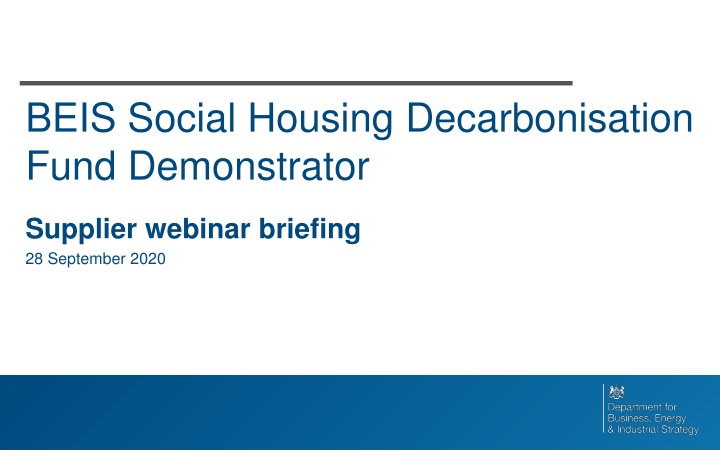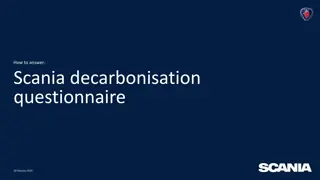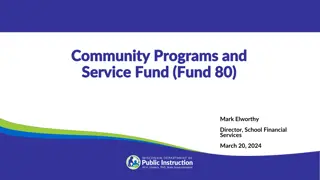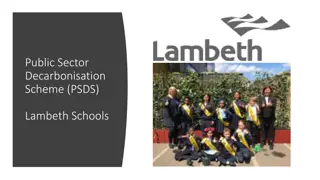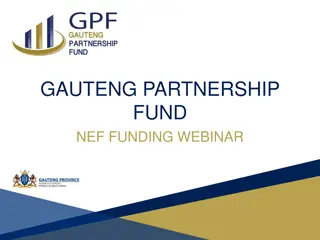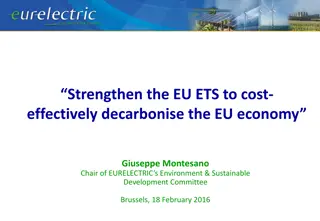BEIS Social Housing Decarbonisation Fund Demonstrator Supplier Webinar Briefing
This briefing outlines the aims of the BEIS Social Housing Decarbonisation Fund Demonstrator Supplier Webinar held on 28th September 2020. It focuses on the competition background, delivering net-zero carbon targets, Clean Growth Strategy commitments, and policy responses to decarbonize the UK's economy. The event aims to provide information, address stakeholder concerns, and gather feedback for designing the final competition guidelines.
Uploaded on Oct 03, 2024 | 0 Views
Download Presentation

Please find below an Image/Link to download the presentation.
The content on the website is provided AS IS for your information and personal use only. It may not be sold, licensed, or shared on other websites without obtaining consent from the author.If you encounter any issues during the download, it is possible that the publisher has removed the file from their server.
You are allowed to download the files provided on this website for personal or commercial use, subject to the condition that they are used lawfully. All files are the property of their respective owners.
The content on the website is provided AS IS for your information and personal use only. It may not be sold, licensed, or shared on other websites without obtaining consent from the author.
E N D
Presentation Transcript
BEIS Social Housing Decarbonisation Fund Demonstrator Supplier webinar briefing 28 September 2020
Aims of the event: To provide information about the competition purpose and timeframe. An opportunity to put questions to the BEIS team. Confirm contact points to register interest in the competition. For BEIS to gather information to feed into the final competition design. Agenda Time Session 09:30 - 09:40 Welcome and Introduction Selvin Brown 09:40 09:55 Competition Background Sam Balch & Jon Horne 09:55 10:30 Stakeholder Information Lisa Groves 10:30 - 11:00 Q & A
BEIS Social Housing Decarbonisation Fund Demonstrator Competition Background
Delivering net-zero carbon The UK became the first major economy in the world to pass laws to end its contribution to global warming by 2050. UK 2018 greenhouse gas emissions The target will require the UK to bring all greenhouse gas emissions to net zero by 2050, compared with the previous target of at least 80% reduction from 1990 levels. The UK has already reduced emissions by 42% while growing the economy by 72% and has put clean growth at the heart of our modern Industrial Strategy. Achieving our targets with current technologies at current costs will be challenging, but significant economic opportunities.
Targets and Commitments The Clean Growth Strategy, published by BEIS in October 2017 sets out government policies and proposals for decarbonising the UK economy to 2032 As many homes as possible to EPC C by 2035 where practical, cost-effective & affordable Develop trajectory for as many as possible privately-rented homes to EPC C by 2030 Consult on how social housing can meet similar standards Buildings mission halve the energy use of new builds by 2030 and halve cost of renovating existing buildings to similar standards
Our Policy Response Set long Target public funding to where it is needed most Support delivery of regulations with market enabling measures dated standards to provide certainty Across tenures to minimise market distortions and unfairness Linked to existing trigger points for action to maximise impact and minimise cost / hassle For example: Those in fuel poverty In social housing. Overcoming innovation barriers. Access to affordable finance Boost awareness and access to information Build a supply chain for high quality installations.
The Summer Economic update: A Plan for Jobs 0.5B Green Homes Grant Local Authority Delivery (LAD) 50M Social Housing Decarbonisation Fund (SHDF) Demonstrator 1.5B Green Homes Grant Voucher Scheme Raise performance of low- EPC homes through consumer led voucher-based approach Raise performance of low- EPC homes through locally led approach focussed on lower income private housing Raise performance of low-EPC rated social homes by demonstrating innovative "whole house" approaches AIM Homeowner or Private/ Social Landlord England only Local Authorities EPC ratings E or below England only UK-wide Local Authorities (incl. consortia) EPC rating D or below Demonstrate cost reduction potential ELIGIBILITY Up to 5000 covering 2/3 total cost, or Up to 10,000 for low-income households (excl. Landlords) Up to 5000 covering 2/3 total cost or Up to 10,000 for low-income households (excl. Landlords) Estimated at between 15 - 30k per dwelling FUNDING (per dwelling provided by BEIS)
Case for Action: Retrofit innovation & Social Housing Longer investment time horizon of social landlords more aligned with deeper "whole house" retrofit Social housing tends to be more homogenous which supports replication and economies of scale which can drive cost reduction and innovation Deeper retrofit likely to be required on significant number of social homes under the wider Social Housing Decarbonisation Fund ( 3.8bn commitment of new funding in the manifesto) Potential for demonstration effect, leading to spill over benefits for the private housing stock
How does the SHDF Demonstrator relate to other schemes? The demonstrator upscales the existing Whole House Retrofit (WHR) Innovation Competition. 7.7m has been awarded as part of the WHR programme. This demonstrator phase is a short-term investment to learn lessons and innovate ahead of the main Social Housing Decarbonisation Fund, allocations for which will be determined at the forthcoming Spending Review in the Autumn. The manifesto committed 3.8bn of new funding for the SHDF.
SHDF Demonstrator Key outputs Social Housing Decarbonisation Fund Demonstrator A 50m grant fund to deliver innovative retrofit projects for social housing demonstrating a targeted performance level and cost reduction The key outputs of the fund are: Retrofit around 2,200 homes in total with measurable improvements in energy performance Demonstrate routes to cost reduction through innovation that could be replicable at scale Increase green jobs in the retrofit sector as part of the wider Covid-19 economic recovery
Key objectives of the SHDF Demonstrator: Improve the energy efficiency of social houses through a whole house retrofit approach Reduce the cost of a whole house approach to retrofitting social housing Support jobs and wider economic stimulus What has changed from the Whole House Retrofit competition? Modest relaxation of energy performance target Additional measures that target other priorities within LA s climate emergency local action plans are allowed so long as the energy performance target can be met, and the project complies with CDM, PAS 2035 and PAS 2030 Simplification of application forms to reduce administrative burden Change in grant award mechanism from Grant Funding Agreement to Memorandum of Understanding
Social Housing Decarbonisation Fund Demonstrator Stakeholder Information
What do we want applicants to demonstrate? A successful applicant would need to be able to demonstrate that they can: Bring together a strong delivery team, including a Retrofit Coordinator Identify groups of suitable dwellings in which retrofit is to be undertaken and secure permission from the occupants for retrofit to take place Procure skills and materials from the retrofit supply chain in a timely manner Measure baseline dwelling performance to understand retrofit needs Design and implement retrofits Measure actual performance and demonstrate cost reduction Oversee delivery of retrofit in such a way as to avoid adverse consequences, e.g. overheating, problems associated with damp etc. Coordinate all of the above to deliver successful design-to-benefits retrofit
Eligibility criteria Must be within the competition scope and located within the UK The project must be led by a Local Authority (consortia with a single lead Local Authority are acceptable) Applicants must declare that they have considered the proposal in relation to State Aid rules and are content it will comply, both in terms of direct receipt of funds and intended use/expenditure of those funds. Non-domestic not eligible and must focus on social housing. Buildings over 18m are not eligible (i.e. high rise flats) The lead applicant acknowledges the conditions outlined in the scheme s published Memorandum of Understanding, which will need to be agreed and signed at pace in the event of a successful bid in order to meet a strict delivery timeline.
Scope of the competition (1) Scope item Energy demand reduction Applicants must demonstrate how they will achieve at least a 50 kWh/m2 performance figure, which MUST be achieved in compliance with PAS2035 Cost reduction The project must provide a detailed explanation of how a cost reduction of between 5-30% will be achieved within the delivery of this project. Summary Assumptions Applicants should specify their sampling and performance testing approach to demonstrate the reduction is being achieved post-installation. Applicants are to provide robust and credible evidence of current costs to demonstrate the baseline for measuring the cost reduction Projects must provide evidence in their reporting as to the sources of cost reduction. Quotes and indicative budgets will be required, along with appropriate contingency allowances in order to demonstrate value for money. Applicants will need to evidence their procurement approach Supply chain Applicants should outline how they propose to effectively measure the number of jobs being created/supported Applicants must explain how they have selected an appropriate number of dwellings to demonstrate achievement of cost reduction in a replicable manner. Buildings over 18 meters are excluded. Scale Focus should be on dwellings with an existing Energy Performance Certificate rating below C and below (i.e. Not at A-C).
Scope of the competition (2) Scope item Focus Summary The focus must be on social housing. Where leaseholder or freeholder (right to buy) properties are a component of an application, SHDF Demonstrator grant funding and match funding must be used on those properties, without costs being passed on to leaseholders/freeholders. Projects are expected to demonstrate how process innovation can lead to cost reductions Assumptions The Authority and Consortium members must ensure that the project as a whole does not receive Government funding above the level permitted by State Aid requirements. Individual property assessments to determine appropriate measures must be undertaken on all properties Innovation Projects should be carried out to strict safety standards The project should seek to measure the impact of the retrofit on the occupants and show consideration to managing the risk of unintended consequences Measures must be installed within 12 months, followed by at least 6 months of energy performance monitoring Applicants will need to detail their compliance with appropriate safety and construction standards Occupant engagement and advice will be expected in all projects Safety Health, Comfort, Well- being and Unintended Consequences Projects must complete installation of measures within 12 months, at which point a final installation report is due Timescales
Funding criteria State aid Where grants would class as State Aid, the General Block Exemption Regulation (GBER) will apply to legally binding agreements signed before 31/12/2020 or to such agreements signed afterwards that fall within the scope of the Northern Ireland Protocol. This includes amongst other things conditions on max grant awards and eligible costs. Specifically, Article 25 (Aid for research and development projects) will be relevant. Funded activities will fall within Experimental Development Max. aid intensities 25-60% (according to organisation/project type) so applicants will need to identify match funding Applicants will be responsible for demonstrating they comply with the general conditions of GBER and any aid intensity uplift they seek to use.
Eligible costs Funding can be used for: Staff costs Material costs Equipment costs Travel & subsistence Funding cannot be used for: Profit The development of new technologies Protection of IPR To cover interest payments, Hire Purchase agreements, or repay fines Any VAT you are able to recover from HM Revenue & Customs
Monitoring & Evaluation Key Performance Indicator Breakdowns Number and nature of the partnerships or relationship set up e.g. with Housing Associations or community groups that will facilitate household identification and engagement Number of installers/suppliers engaged during pre- market engagement and who apply for delivery contracts Total engaged Total applicants Number and value of contract issued to installers/suppliers Total contracts awarded Total unsuccessful applicants Number of eligible homes identified as eligible Number of homes contacted Starting EPC band/ Initial energy efficiency rating in kw/m2 pa Number of home agreeing to an installation Dates of each Whole House Retrofit Start and end date Cost to LA of each Whole House Retrofit Total cost. Cost for each measure, design, installation, OPEX, Capex Number of people working (FTE) per project Total of which apprenticeships Installations carried out Number of installations, type of measure installed and expected bill savings Number of homes improved to 50kw/m2 pa or higher Final energy efficiency rating Event title Vision and Objectives
Timeframe Application window - - - - Application form & guidance document published w/c 28th September 2020 Clarification questions by 17:00 16th October 2020 EOIs register your interest at SHDF.demonstrator@ricardo.com by 17:00 16th October 2020 Deadline for receipt of applications is 17:00 Thursday 12th November 2020 (6 weeks post launch date) Oct & Nov 2020 Awarding Grants Mid Nov Dec 2020 - - BEIS officials and sector experts assess applications and notify applicants of the results MoUs issued and milestone schedules agreed Project Begins Early Dec 2020 - Dec 2021 - - - Installation of measures Milestone achievements; quantitative, qualitative, evidential and assurance checks will be carried out Regular reporting to BEIS Monitoring Officers and hosting their monthly site visit Monitoring & evaluation Jan - June 2022 - - In-situ performance monitoring of treated properties Project final report demonstrating achievements 30th June 2022
Contact Email SHDF.demonstrator@ricardo.com BEIS Website
